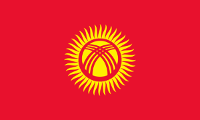Russian in Central Asia
One thing that is different about Russian in Central Asia, which is not at all surprising, is that you get all sorts of Central Asian words mixed in. Let me give you two examples.
In downtown Bishkek the roads are lined with trees. The trees make the city much more attractive than it would be otherwise, but let me tell you: there is not a ficus's chance in hell they could grow here without irrigation. It is way too dry. So the streets are lined with small irrigation channels that are called ары́ки. Now the word ары́к doesn't have a Slavic feel to it right off the bat, and in fact it seems to be derived from one of the Turkic languages, perhaps Kazakh or Turkish or Kyrgyz (though I haven't confirmed the word in Kyrgyz yet). The other day I was chatting with a Kyrgyz acquaintance and commented on the aryki, and I said that they didn't have them in Moscow or Petersburg. He commented that they did have them, it was just thaqt in those cities they were covered with grates. I think he is mistaken. True, there are grate-covered channels in Kazan and Moscow and Petersburg, but I think they are mostly for run-off, not for irrigation. In those other cities there is enough rain to support trees and grass without the channels.
The next example comes from the Russian Wikipedia article on арыки. It reads: «Для контроля за арыками в городах и сёлах назначают «арычных старейшин». В их роли обычно выступают старосты кишлаков, мирабы и городские и сельские общины.» The words кишлак and мираб are completely non-standard Russian, even though can find them in Russian dictionaries. They mean ‘village’ and ‘water boss’ respectively. But if you live in Central Asia you know these words, just like in Arizona you know words like ‘pueblo’ and ‘jefe.’
One last linguistic comment: the word мираб is quite interesting because it combines an Arabic root 'mir' meaning 'lord, master' and a Persion root 'ab' meaning water, which suggests that the Turkic languages borrowed it from Persian.
Lamination: the six-case sheet lives on
Russian has confusing noun and adjective endings (which are called ‘cases’) so I usually distribute to my second-year students a reference sheet simply entitled “The six-case sheet.” I usually do that in the summers, too, once I find a place to laminate them so that they hold up better. Alas, I could not find any place that did that. Now I have, and not in international looking, big stores on a main street.
Two of the main streets of Bishkek are Chuy and Sovetskaya. Where they intersect there are underground passageways to cross the intersection so that pedestrians don't hinder the major traffic. And along these passageways are dozens of little kiosks/shops that sell this and that. This area is called a подходка by the locals, and within are some copy shops that have laminating machines. Whodathunkit?
So on Monday the students will have Livingston's world-renowned six-case sheet.

